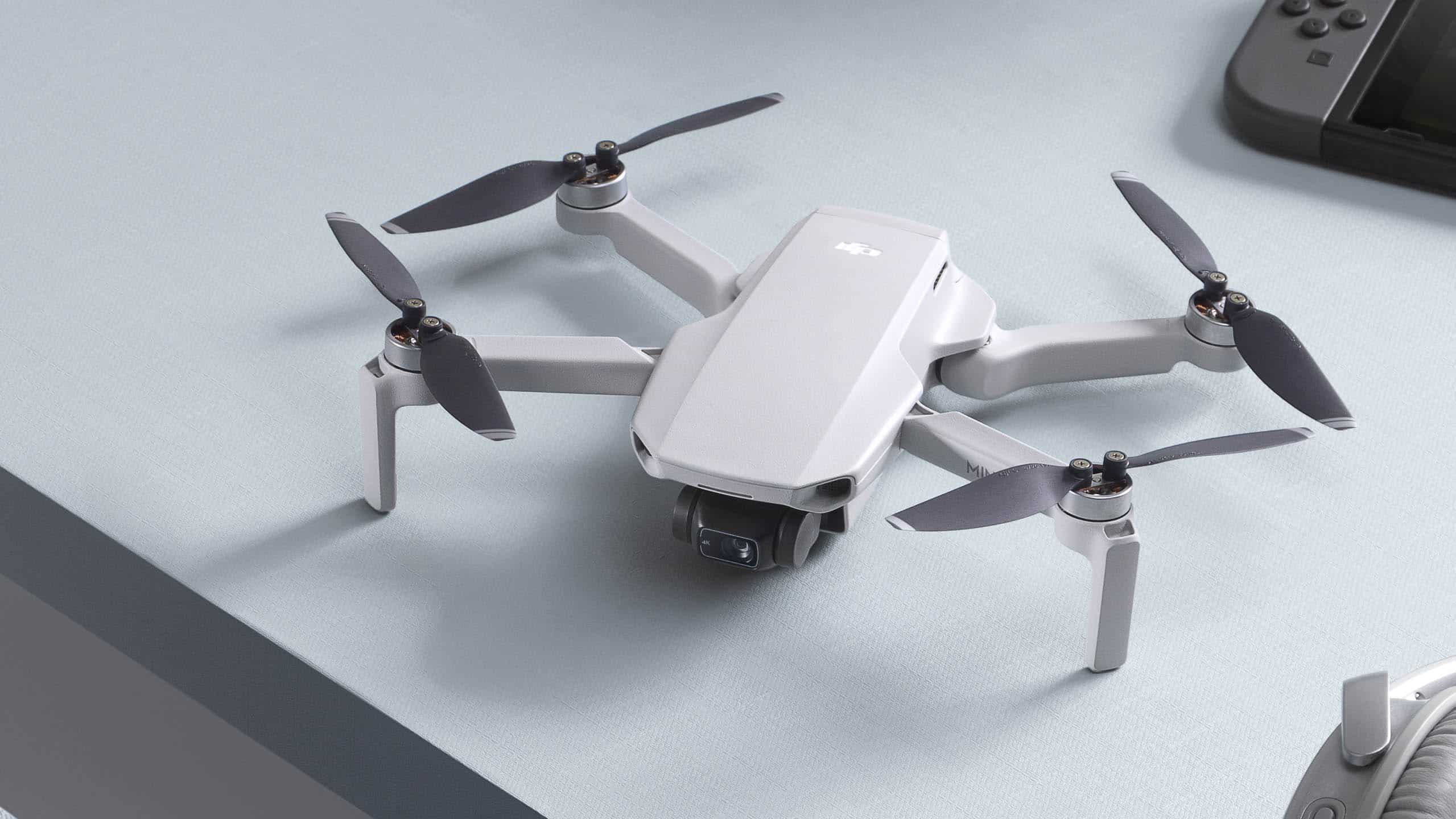So the new Mavic Mini’s first surprise is that it isn’t a ‘Mavic’ at all, according to its arm. It just says ‘Mini 2’ now, though this is still very much the same airframe which sold so many in the year since its October 2019 launch. Back then the ultra-light drone proved that you don’t need to spend the most to get a great drone. In fact the DJI Mavic Mini really supports our ‘It’s Not The Gear’ stance, not just producing decent video but doing so under the crucial 249g weight limit that saves folk from registering in the USA and much of the rest of the world.

So why a new model (and why so soon?)
The DJI Mini 2 offers four principle improvements over its predecessor, while retaining the crucial benefit of staying below the registration weight limit:
- 4K Video: Doubling the pixel count of the video from 2.7K will help compete with modern phones.
- 10 km/6 mile dual-band radio control: DJI’s OcuSync 2.0 technology will make for much more reliable control signals.
- More Powerful Motors: A slightly longer 31-minute flight time, against a breeze of up to 24 mph.
- Camera Raw
These are just the headline figures, of course. There are also software improvements which will offer additional camera features and file downloading features. DJI’s lifestyle images also appear to show an all-new remote control rather like the excellent one seen with the Mavic Air 2. For more details read on, or (if you’re impatient and generous) rush straight to the DJI store link (it is an affiliate link scheme, but it doesn’t affect the price you pay).
In a moment we’ll start scouring the press release for the detail (a proper review will follow only once we’ve actually experienced the aircraft), but first I hope you’ll forgive a bit of theorising; I think that this new “Mini 2” (or Mavic Mini 2 as we could call it) has arrived because the target market — consumers — are starting to simply expect 4K in their video. It’s on their phones after all. At the same time, drone operators are starting to find regulations ever more cumbersome, but pro clients definitely expect 4K, so here’s a chance to sell some backup drones to pros who might have turned their noses up at 2.7K. As for the OcuSync 2.0 that seems a very generous addition to a machine near the bottom of the range; but if you’ve ever flown the original Mavic Mini you will absolutely see the need. That drone quoted a 4,000m radio range, but in practice it could get itself into trouble much closer to the pilot than that, whereas experience with OcuSync 2.0 on other aircraft has always seemed to live up to the claims, no doubt thanks to the automatic dual frequency switching (though I’ve never tested it in Japan, where the use of one of those bands is not allowed).
DJI Mini 2 Camera Improvements

A quick inspection of the new DJI Mini 2’s camera reveals that it’s sporting a 4K graphic to the side of the 12-megapixel lens, just so it’s very clear that the camera upgrade is a significant aspect, and the higher resolution will be a popular feature. While I took the kinder view that 2.7K was the maximum on the Mavic Mini because there were processing limitations (for weight reasons) and a budget to keep the components under, iPhone users have been shooting in 4K since the 6S in 2015 making a lower resolution seem a bit more like positioning, and that positioning not seem all that easy to justify.
The other feature, alongside 4K, that is popular with enthusiasts and pros is Raw and this, too, was left out of the Mavic Mini but is now an option for photographers looking for a bit more flexibility in post-production.
In addition x2 digital zoom is available on this model (or part optical, part digital up to 4x in the 1080P mode). Indeed perhaps there is a bit more processing power on board, since the announcement mentions:
- Panorama Mode: Sphere (26 images stitched)
- Panorama Mode: 180˚ (7 images stitched)
- Panorama Mode: Wide-Angle (3×3 images stitched)
- AEB Triple Shot with HDR post-processing option
- Timed Shots
The Drone will also offer five pre-programmed movements, called QuickShots. These are Dronie, Helix, Rocket, Circle & Boomerang, all of which are customisable in terms of starting position and, often, range. All of these have proven popular (and effective) on previous models – the Panorama modes seem to be the latest versions as seen on the Mavic Air 2 (you can check the price here, but that 4K drone is not far off $1000/£769).
Powering Up: Mavic Mini in the Wind
The Mavic Mini did not enjoy breezy days. That wasn’t the fault of DJI, but an inevitable limitation which came from ensuring that all four motors, the battery and all the other components came to under 249g, (that’s 100g less than the weight of a small latte). Nonetheless the firm do claim an improvement has been achieved for the 2020 edition, adding a minute to the drone’s flight time (already one of DJI’s best) and making the drone capable in up to 24mph gusts. Rest assured we’ll test this as soon as possible, but any improvement here is to be considered good news.
OcuSync 2.0: Dual-Band Goodness
The DJI Mini’s inclusion of much-requested DJI proprietary radio technology OcuSync 2.0 will make many serious customers who had been sitting on the fence very happy indeed. While the 2.7K video was actually surprisingly usable in many circumstances (how often can you really tell you’re watching 4K? It’s less than you think), the tendency of the radio control system to begin to lose connection before you’d reached the 500m (0.3 miles) you’re legally allowed to fly here in the UK was a problem. The specs promised 4000m but the ‘Enhanced WiFi’ radio simply wasn’t as effective at handling interference as the excellent OcuSync.
If you’d risked flying on a less-than-ideal day, breeze wise, or the wind had climbed up a few knows without you noticing, you could very quickly find yourself blowing outside the range in which you had any control over your aircraft. That’s not to say that you immediately have no influence over the direction of the drone – it’s the video feedback that fails first – but once that has dropped out and your Mini drone is a couple of hundred meters away and drifting faster than you can bring it back, it starts to get very hard to work out which way your drone is pointing, let alone if you can bring it back!
This is solved at a stroke – more powerful motors give you a little more wiggle room, and better radio means you get the back-up of the camera’s video feedback for longer (also making a remote emergency landing via the camera feedback possible, if still far from the preferred solution).
DJI Mini 2 Accessories
By using the same airframe as the Mavic Mini, the Mini 2 is compatible with the existing DJI Mini Bag, Charging Display Case (the very weird bell jar), DIY Creative Kit (the colourful stickers), and the Snap Adapter (the LED screen you can use to make messages hover near their intended readers). DJI are also offering their Care Refresh insurance packages which might suit anyone who wasn’t planning on being too careful).
Price
For the latest price, check the DJI Store:



